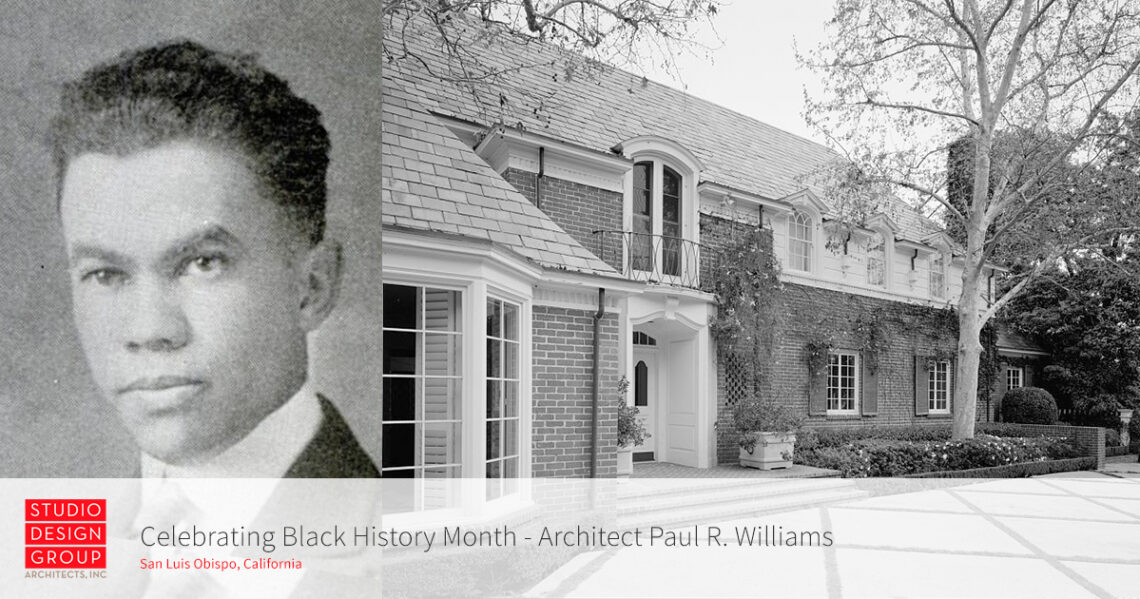
In honor of Black History month, Studio Design Group would like to introduce architect, Paul R. Williams. Throughout much of the last century, Williams was a quiet leader in architecture, designing thousands of structures in and around Southern California, yet his name is unfamiliar to many, including those in the building industry.
“I had never heard of Paul R. Williams, even though I grew up just an hour from L.A. and studied architecture nearby,” says SDG’s Ellen Adamson Goodwin, “I believe that learning about influential figures can shift the paradigm of architecture as a whole, and expand the breadth of creative ideas, knowledge, and experience in the field.”
The context of Paul Williams’ early years amplifies his significant achievements even more. He was born in 1894, when our country was steeped in segregation and deep racial divides. By 1900, he was orphaned and living in foster care but, as he grew, his dream of becoming an architect never wavered. Throughout his lifetime, from studying as the only African American child in his elementary school to being banned from the buildings he himself had designed, Williams was acutely aware of his societal disadvantages as a black man.
But Paul Williams never recognized his race as an obstacle. Before the age of 30, he had become the first black graduate from the University of Southern California, the first black architect west of the Mississippi, the first black member of the American Institute of Architects (AIA), and he was appointed to serve on the first Los Angeles Planning Commission.
Williams is said to have repeatedly noted the irony of his “position” as a black architect. Even though he had designed and overseen the construction of hundreds of buildings, as a black man he was forbidden to enter many of them. Worried that his affluent white clients might be uncomfortable sitting next to him while he presented his designs, Williams taught himself to draft upside down, so that he could draw plans from across the table from the client, a talent that quickly became his trademark.
In spite of his disadvantages, Williams designed over 2,000 buildings in southern California throughout his prolific career. His iconic Los Angeles buildings include Saks Fifth Avenue, Beverly Hills; Woodrow Wilson High School; Golden State Mutual Life Insurance Building; First A.M.E. Church; and The Beverly Hills Hotel, whose logo is in Williams’ own handwriting.

First African Methodist Episcopal Church of Los Angeles
Paul Williams became known as the “Architect to the Stars,” among the Hollywood elite. His residential projects include the homes of Danny Thomas, Frank Sinatra, Lucille Ball, Lon Cheney, Tyrone Power, and many other notable celebrities. Yet, in seemingly paradoxical efforts, Williams also co-designed some of the first federally funded housing projects in L.A. He was known to have said at the time that, “Expensive homes are my business and social housing is my hobby.”

Morris Landau House – Pool house plans by Paul R. Williams. House pictured above.
Almost a century later, many of Williams’ buildings still stand, and several are listed in the National Register of Historic Places. In 2017, Williams was posthumously awarded the AIA’s prestigious Gold Medal, the organization’s highest honor.
Williams’ story is another reminder of how and why representation matters. In February 2020, PBS aired a documentary about Williams’ life. From the episode: “There is a sense that we need to have more people of color and diversity in architecture to understand the nuances of communities that are going to be built for the future.”
As this recent LA Times article notes, the field of architecture remains “glaringly white.” In 2018, the AIA estimated that its membership was only 2% black, and that only 0.4% of licensed architects are black women.
In 2006, the Memphis chapter of the AIA started The Paul R. Williams Project to increase awareness of this inspirational man. Their website is a wonderful resource for more information on Williams’ life and works.
This Black History Month, we are reminded to honor and celebrate those who overcame adversity to pave the way for others. Revisiting history and learning about influential figures can help us to better adapt to change, understand our own place in society, and encourage us to expand our creative vision.
To learn more about SDG, please explore our website, or give us a call at 805-541-3848.
